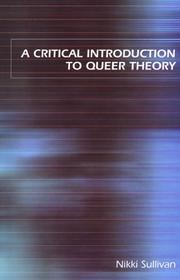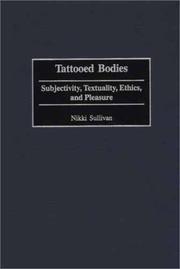| Listing 1 - 7 of 7 |
Sort by
|

ISBN: 0814798403 0814798411 9780748615971 Year: 2007 Publisher: New York : New York University Press,
Abstract | Keywords | Export | Availability | Bookmark
 Loading...
Loading...Choose an application
- Reference Manager
- EndNote
- RefWorks (Direct export to RefWorks)
"This book is a succinct, pedagogically designed introduction. As classroom text, Sullivan's work is heady with vibrant debate and slim heuristics; her intellectual clarity is stunning." -'Choice' A Critical Introduction to Queer Theory explores the ways in which sexuality, subjectivity and sociality have been discursively produced in various historical and cultural contexts.The book begins by putting gay and lesbian sexuality and politics in historical context and demonstrates how and why queer theory emerged in the West in the late twentieth century. Sullivan goes on to provide a detailed overview of the complex ways in which queer theory has been employed, covering a diversity of key topics including: race, sadomasochism, straight sex, fetishism, community, popular culture, transgender, and performativity. Each chapter focuses on a distinct issue or topic, provides a critical analysis of the specific ways in which it has been responded to by critics (including Freud, Foucault, Derrida, Judith Butler, Jean-Luc Nancy, Adrienne Rich and Laura Mulvey), introduces key terms, and uses contemporary cinematic texts as examples.
Homosexuality --- Queer theory. --- Philosophy. --- Gay and lesbian studies --- Transgender people.

ISBN: 0748615970 147447294X Year: 2010 Publisher: Edinburgh Edinburgh University Press
Abstract | Keywords | Export | Availability | Bookmark
 Loading...
Loading...Choose an application
- Reference Manager
- EndNote
- RefWorks (Direct export to RefWorks)
Explores how sexuality, subjectivity and sociality have been discursively produced in various historical and cultural contexts The book begins by putting gay and lesbian sexuality and politics in historical context and demonstrates how, and why, Queer Theory emerged in the West in the late twentieth century. It goes on to provide a detailed overview of the complex ways in which Queer Theory has been practised. Topics covered include: Race Sadomasochism ‘Straight’ sex Fetishism Community Popular culture Transgender Performativity Each chapter focuses on an issue or topic, provides a critical analysis of the specific ways in which it has been responded to by critics (including Sigmund Freud, Michel Foucault, Judith Butler, Jacques Derrida, Jean-Luc Nancy, Adrienne Rich and Laura Mulvey), and introduces key terms. Each chapter also discusses contemporary cinematic texts. Key Features Extends current accounts of Queer Theory by analysing its relation to our everyday lives Provides historical overviews of key concepts such as heterosexuality, sadomasochism and fetishism Up to date coverage of issues and debates Examples are taken from contemporary popular cultural texts such as films, documentaries and art projects.
Sociology of the family. Sociology of sexuality --- Homosexuality --- Gays --- Queer theory. --- Gender identity --- Identity (Psychology) --- Philosophy. --- Identity. --- Gay people

ISBN: 0275966755 Year: 2001 Publisher: Westport (Conn.): Praeger
Abstract | Keywords | Export | Availability | Bookmark
 Loading...
Loading...Choose an application
- Reference Manager
- EndNote
- RefWorks (Direct export to RefWorks)
Human body --- Tattooing --- Social aspects --- Symbolic aspects
Book
ISBN: 9781474472944 Year: 2022 Publisher: Edinburgh
Abstract | Keywords | Export | Availability | Bookmark
 Loading...
Loading...Choose an application
- Reference Manager
- EndNote
- RefWorks (Direct export to RefWorks)

ISBN: 9781474472944 9780748615971 0814798403 0814798411 Year: 2003 Publisher: New York : New York University Press,
Abstract | Keywords | Export | Availability | Bookmark
 Loading...
Loading...Choose an application
- Reference Manager
- EndNote
- RefWorks (Direct export to RefWorks)
"This book is a succinct, pedagogically designed introduction. As classroom text, Sullivan's work is heady with vibrant debate and slim heuristics; her intellectual clarity is stunning." -'Choice' A Critical Introduction to Queer Theory explores the ways in which sexuality, subjectivity and sociality have been discursively produced in various historical and cultural contexts.The book begins by putting gay and lesbian sexuality and politics in historical context and demonstrates how and why queer theory emerged in the West in the late twentieth century. Sullivan goes on to provide a detailed overview of the complex ways in which queer theory has been employed, covering a diversity of key topics including: race, sadomasochism, straight sex, fetishism, community, popular culture, transgender, and performativity. Each chapter focuses on a distinct issue or topic, provides a critical analysis of the specific ways in which it has been responded to by critics (including Freud, Foucault, Derrida, Judith Butler, Jean-Luc Nancy, Adrienne Rich and Laura Mulvey), introduces key terms, and uses contemporary cinematic texts as examples.
Literature --- Homosexuality --- Queer theory. --- Gay and lesbian studies --- Transgender people. --- Philosophy.
Book
ISBN: 0754697851 9780754697855 1282295128 9781282295124 9780754675303 0754675300 1317052749 131560986X 9786612295126 9781315609867 9781317052739 9781317052746 9781138276871 1409491978 Year: 2016 Publisher: London ; New York : Routledge,
Abstract | Keywords | Export | Availability | Bookmark
 Loading...
Loading...Choose an application
- Reference Manager
- EndNote
- RefWorks (Direct export to RefWorks)
Somatechnics highlights the reciprocal bond between the sôma and the techné of 'the body' and the techniques in which bodies are formed and transformed as crafted responses to the world around us. The volume's contributions to the work of Spinoza, Nietzsche, Merleau-Ponty, Deluze and Guattari make it a must read for scholars of sociology, cultural and queer studies and philosophy.
Book
ISBN: 9780815359623 9781032085944 0815359624 1032085940 1351120166 1351120174 1351120182 Year: 2020 Publisher: London ; New York (N. Y.) : Routledge,
Abstract | Keywords | Export | Availability | Bookmark
 Loading...
Loading...Choose an application
- Reference Manager
- EndNote
- RefWorks (Direct export to RefWorks)
Queering the Museum develops a queer analysis of the ways in which museums construct themselves, their core business, and their publics through the, often unconscious, use of inherited ways of knowing and doing. Providing a critique of both the practices and conventions associated with the modern public museum, and the ontological assumptions that inform them, the authors consider recent discourse around inclusion in museums and explore the ways this has been taken up in practice. Highlighting the limits of particular approaches to inclusion, and the failure to move away from a traditional museological paradigm, the book outlines an alternative critical museological approach that the authors refer to as 'queer'. Providing readers with the critical tools necessary for a profound rethinking of museum practice, the book also responds to and problematises the growing call for social inclusion. Queering the Museum will appeal to academics, students and museum and arts sector practitioners with an interest in critical theory or queer practice. It will be of particular interest to those working in the fields of museum studies, sociology, archaeology, anthropology, cultural studies, media, social policy, politics, philosophy and history
Théorie queer --- Musées --- Queer theory. --- Museums. --- Aspect social. --- Aspect politique.
| Listing 1 - 7 of 7 |
Sort by
|

 Search
Search Feedback
Feedback About UniCat
About UniCat  Help
Help News
News